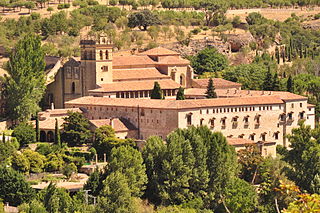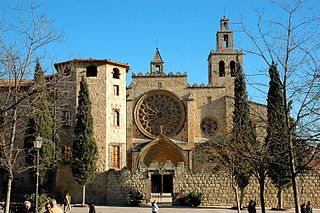
The Monastery of Sant Cugat is a Benedictine abbey in Sant Cugat del Vallès, Catalonia, Spain. Founded in the ninth century, and under construction until the 14th century, it was the most important monastery in the county of Barcelona. Its most notable architectural feature is its large Romanesque cloister.

Santa Maria de Gerri is a monastery in Gerri de la Sal, in the comarca of Pallars Sobirà, Catalonia, Spain, situated on the shores of the Noguera Pallaresa river.

Sant Esteve de Banyoles is a Benedictine monastery in Banyoles, Pla de l'Estany, Catalonia, Spain. It was declared as a Bé Cultural d'Interès Nacional landmark in 1973. The monastery was founded before 812.

Sant Llorenç del Munt is a Benedictine monastery in Matadepera, Vallès Occidental, Catalonia, Spain. It is situated on top of La Mola, the summit of the rocky mountain massif, Sant Llorenç del Munt, within Parc Natural de Sant Llorenç del Munt i l'Obac. It was declared a Bien de Interés Cultural landmark in 1931.
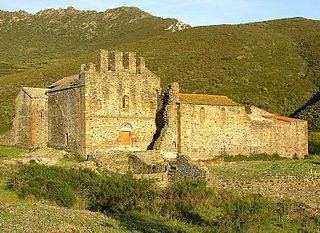
Sant Quirze de Colera is a Benedictine monastery in Rabós, Catalonia, Spain. The 9th-century building, in First Romanesque style, was declared a Bien de Interés Cultural landmark in 1931.

Sant Pere de les Puelles is a Benedictine monastery in the Sant Pere, Santa Caterina i la Ribera neighborhood of the Ciutat Vella district of Barcelona, Catalonia, Spain. The 10th-century building, Romanesque/Gothic in style, was declared a Bien de Interés Cultural landmark in 1931.
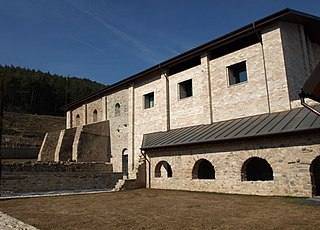
Sant Llorenç prop Bagà is a former Benedictine monastery in Catalonia, Spain. The Romanesque building is located near Guardiola de Berguedà in comarca Berguedà.

Sant Salvador de la Vedella is a Benedictine monastery Catalonia, Spain. The Romanesque building is situated near the municipality of Cercs, in Berguedà comarca, province of Barcelona. It was founded by the monks of the Monastery of Sant Serni de Tavèrnoles in the year 830. Carlot Tavèrnoles became the abbot in the 835. After the 12th century its importance declined. Until the year 1580, it was associated with the seminary at La Seu d'Urgell.
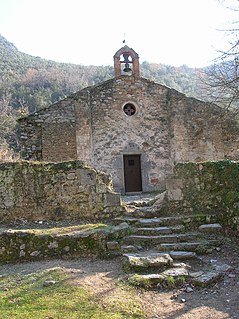
Sant Aniol d'Aguja is a Benedictine monastery in Montagut i Oix, Province of Girona, Catalonia, Spain. It was declared a Bé Cultural d'Interès Nacional in 1983.

Santa Maria d'Amer is a Benedictine monastery in Amer, Selva, Catalonia, Spain.

Sant Pere de Besalú is a Benedictine monastery in Besalú, Garrotxa, Catalonia, Spain. The building was renovated in 1160.

Sant Pere de Camprodon is a Benedictine monastery in Camprodon, Ripollès, Catalonia, Spain. It was declared a Bien de Interés Cultural landmark in 1931.
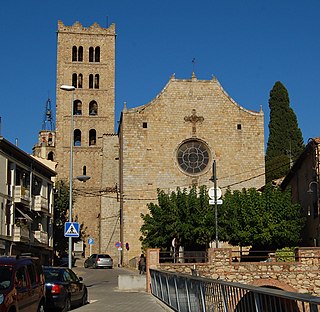
Sant Salvador de Breda is a parish church and former Benedictine monastery in Breda, Province of Girona, Catalonia, Spain.
Santa Cecília de Elins is a former Romanesque Benedictine monastery in the municipality of Montferrer i Castellbò, Catalonia, Spain, to the southeast of the village of Cassovall. It is a Bien de Interés Cultural site. The monastery was documented in 865 but fell into decline in the tenth century. On 29 December 1080 the Bishop of Urgell Bernat Guillem consecrated a new church with three altars dedicated to St. Cecilia, Virgin Mary and Santa Fe. During the fourteenth century it fell into decline and in 1383 it was reduced in status to a priory. By 1680 the monastery fell into ruins. It was converted into a farmhouse in the 1940s.

Sant Pere del Burgal is a Romanesque Benedictine monastery in Escaló, in the municipality of La Guingueta d'Àneu, Pallars Sobirà, Catalonia, Spain. The monastery was first mentioned in a precept of Count Raymond of Toulouse in 859. It later became a priory of the abbey of Roussillon. It fell into decline and was secularized in 1570 and confiscated in 1835. It contains frescoes dated to the 11th century.

Sant Pere de Graudescales is a Romanesque Benedictine monastery in La Valldora, in the municipality of Navès, Solsonès, in the Province of Lleida, Catalonia, Spain. It lies to the north of Navès and west of Berga. It was consecrated in 913 by the Bishop of Urgell. From the fifteenth century it was used as a parish church until 1837 when it was abandoned and gradually fell into ruin. Sant Pere de Graudescales was excavated and restored during the second half of the 20th century.

Sant Pere de les Maleses is a Benedictine cave monastery in the municipality of La Pobla de Segur, Pallars Jussà, in the Province of Lleida, Catalonia, Spain. the monastery was first mentioned in 868 when it was dedicated to St. Andrew and was donated to St. Vincent of Oveix, the abbot of Attila. During the tenth or eleventh century it ceased to be owned by Oveix and was rededicated to St. Peter. It later fell under ownership of Santa Maria de Gerri, and lost its status as a monastery. It was secularized in 1592 and from then on became a simple church.

Sant Serni de Tavèrnoles is a Romanesque Benedictine monastery in Anserall, in the municipality of Les Valls de Valira, Alt Urgell, in the Province of Lleida, Catalonia, Spain. It became a Bien de Interés Cultural site on 3 June 1931 and was restored in 1971.

The Casbas Monastery, also known as the Monastery of Santa Maria de la Gloria, is in Casbas de Huesca, a municipality in the province of Huesca, Aragon, Spain. A Bien de Interés Cultural, it was established in 1173 by Countess Oria de Pallars with the support of her husband Arnau Mir, Count of Pallars Jussà, between 1124 and 1174, and the Bishop of Huesca, Esteve de Sant Martí. Bishop Esteve had previously been the abbot of the Cistercian Monastery of Poblet from 1160 until 1165. The first abbess was Isabel, who ruled over the 30 noblewomen who entered the community until 1182. The abbess of Casbas had civil and criminal jurisdiction over her lands beginning in 1178. The Benedictine community of women formally came under the auspices of the Cistercian order in 1196, recognized as such by Pope Celestine III.

